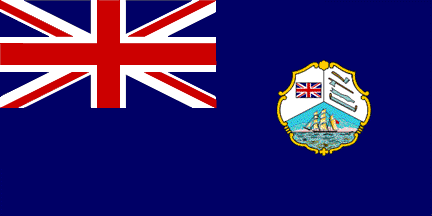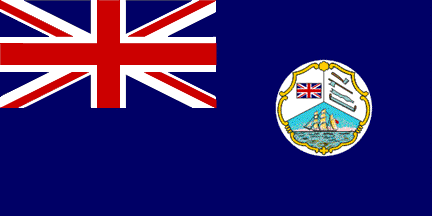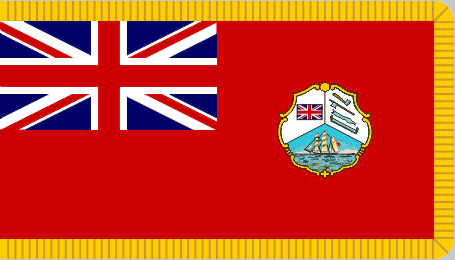
British Honduras Blue ensign 1919-1981
image by Martin Grieve, 6 August 2005

Last modified: 2012-01-20 by zoltán horváth
Keywords: belize | british honduras | colony | colonial | honduras | sledghammer | saw | axe | oar | ship |
Links: FOTW homepage |
search |
disclaimer and copyright |
write us |
mirrors

British Honduras Blue ensign 1919-1981
image by Martin Grieve, 6 August 2005
See Also:
This flag is a standard British Blue Ensign, with the badge of
British Honduras. The badge is divided in three portions. In the
first field, there is a Union Jack on a white background. This
makes two UJ's on the flag. The second field displays four tools,
also found on the Coat of Arms. The four tools are: a
sledgehammer, a saw, an axe and an oar. The bottom field shows a
ship sailing toward the hoist. The ship is flying a red flag,
probably a British Red Ensign. This flag was used as the
Colonial flag of British Honduras, and was then used as a state
and war ensign until the 80's.
Željko Heimer, 22 July 1996
According to Crampton's The World of Flags 1990, the
Coat of Arms was granted in 1907 (see above). However, Crampton
does not say which of the Coat of Arms or the badge came first. A
possible theory would be that the badge was designed before the
arms. In effect, the ship at sail is a clear sign of late 19th
century Caribbean colony designs. Thus, the 1907 coat of arms
must have been an attempt to make the badge more 'heraldically
correct', and so, the badge must have come before the arms. This
is an educated guess, but a guess nonetheless. Which preceded
which is still unclear.
Roy Stilling, 22 July 1996
Belize was known as British Honduras until 1973. Badge
approved 1870 and apparently displayed on a white disc until
about 1920. A letter dated 12-dec-1919 was sent to the
Crown Agents (who supplied flags to British Honduras), telling
them that there should be no white circle on the British Honduras
Blue Ensign. This flag continued to be used until probably 1981.
David Prothero, 6 March 1999
The old Coat of Arms was granted by Royal warrant on 28 Jan.
1907 . Note: this is the date for the CoA, and not the colonial
badge. As Roy says ,the badge probably came earlier (perhaps
1860s).
The current Coat of Arms was adopted at independence and differs
only in minor details (e.g. the UJ was eliminated from the canton
of the shield). Differences in the shape of the scroll etc. are
probably heraldic license and not new Coat of Arms . The
supporters used to be both Black. The dexter one (viewer's left)
is now White/Hispanic -- I suppose that was a change at
independence.
T. F. Mills, 27 March 1999
Illustration of this flag appears in p. 108 (bottom) at [zna99], with two rows of three Blue
Ensigns each. In the first row there is "British Honduras
(XIXth century - 1981)".
Ivan Sache, 25 Febuary 2001
Smith [smi80] show it only as
---/-SW ensign (that is probably on state ensign, as I doubt that
Belize had a navy). The matching civil ensign is simple undefaced
British red ensign.
Željko Heimer, 4 March 2001
British Honduras used a circular seal in ornamental frame on
1870 flag.
David Prothero, 8 April 2005
The badge that defaced the blue ensign of British Honduras
Colony was one of the more attractive designs of it's time. It is
partitioned into three sectors, the first containing the Union
flag, the second, a set of logging tools, and the third displays
what was very common on British Colonial flags in the Caribbean
at that time. This is a sailing ship which represents the
transportation of mahogany wood which British Honduras was famous
for.
Gordon and Gordon's 1920's classic flag book, "Flags of the
world" tell us: "British Honduras is the mahogany
colony and it announces the fact in it's badge, a third of which
is occupied by the mahogany feller's tools including the
cross-cut saw; while at the base is a barque with a red ensign
and in the other third is the Union Jack which in the seal is
replaced by the more appropriate mahogany tree"
It is most unusual for a very pro-British empire flag book to
utter the words that the Union Jack was replaced by anything more
appropriate! An extract from the "Flag Bulletin"
pertaining to the new flag of Belize on page 143 of vol. XX:5
dated September-October 1981 reads: "The different elements
combining to form the national flag may be dated back as far as
the early nineteenth century. At that time the local population
was self-governing, since the territory was claimed by Spain and
the British did no more than to insist on the right to cut
timber. A public meeting in 1819 saw the creation of the coat of
arms for use on the seal, the die for which arrived from London
two years later.
In 1907 the design was confirmed by the College of Arms as the
official Armorial bearings of what was then called British
Honduras." On the graphics side, we decided to look into a
great many flag books which depicted the badge detail, and
settled on three sources. These were:
1.) Flags of Maritime Nations, 1912
2.) Das Grossen Flaggenbuch, 1939 (1992 facsimile)
3.) BR20, Flags of all Nations 1958.
There are some noticable differences between these three
publications, although it could be said that these are very
minor. The greatest cause for concern is the proportions of the
Union flag in the first sector, which has the ratio
of 2:3, 3:5 and 1:2 in the respective sequence from
the publications listed above. What is the best? That depends on
what you prefer of course, but Das Grossen Flaggenbuch will form
the base image of our badge detail with the logging implements
from Maritime Nations. There should be a sunset
between the clouds and the sea, coloured pink but strangely
omitted from Flaggenbuch, and so we shall add this detail as both
BR20 and Marime Nations depict this.
David Prothero informs me that the badge was used from 1870 to
1981, one of the longest, if not the longest use of the same
colonial badge. The white disc was supposed to have been removed
in 1919. That is a time span of 111 years, and I cannot find
anything here to beat that.
Martin Grieve and David Prothero, 6 August 2005

British Honduras (1870-1919/1920)
image by Martin Grieve, 6 August 2005
British Honduras became Belize on 1 June 1973, and so this
flag became the state ensign of Belize from 1973-1981.
Martin Grieve and David Prothero, 6 August 2005

Flag of Lieutenant Governor/Governor - Presumably from
1870-1981?
image by Martin Grieve, 6 August 2005
General Governor of British Honduras. The badge in the middle
is used since at least end of 19th century (approved 1870
according to David Protero) when this flag might have been
inftroduced, too, and the flag was used until presumably 1981.
Željko Heimer, 4 March 2001
No Governor-General until independence. The defaced UJ was for
the Lieutenant-Governor from 1870 until 1884 when British
Honduras ceased to be a dependency of Jamaica, and the
Lt-Governor became a Governor. The badge is recorded in the
Colonial Office Record Book, [Public Record Office document CO
325/54] with an 1870 reference number and a note, "Shield on
circle with garland of mahogany leaves filling the space between
edges of shield and circle." At some point it would have
been changed to a standard laurel leaf garland. Doubtful
whether any flag was actually made with a mahogany leaf garland.
David Prothero, 5 March 2001
British Honduras was governed by Superintendents (subordinated
to the governor of Jamaica) from 1749-1862, Lieutenant Governors
from 1862-1884, and by Governors fom 1884-1981. The flag was a
Union defaced with the badge within a laurel garland.
Martin Grieve and David Prothero, 6 August 2005

Unofficial Red Ensign of British Honduras
image by Martin Grieve, 6 August 2005
Here is a photo of a
badge on red ensign taken by me at a flag display in ICV 19
(York, July 2001). The origilal flag is from Bruce Berry
collection. According to the display catalouge: "The tools
show the forestry trade, the mainstay of the colony's
economy."
This version may have been unofficial or its origin is not clear.
Dov Gutterman, 31 July 2001
Merchant vessels flew a red duster, undefaced although it
appears that red ensigns defaced with the badge of the colony
were manufactered, as Bruce Berry has on in his collection.
Martin Grieve and David Prothero, 6 August 2005
Red Ensign for Ceremonial Use (?)

image by Martin Grieve, 4 September 2005
There was never any official warrant granted to that former
Colony to fly this flag, but I had decided to go ahead simply for
the reason that Bruce Berry had one in his collection. The first
thing that struck me was that this flag had a gold fringe around
it!
David Prothero reckons that this may just have been a ceremonial
flag. and I am tempted to go along with his conclusion.
Martin Grieve, 4 September 2005
I was the one who gave Bruce said ensign. In 1993, I bought
several British Honduras' red ensigns in various (American) sizes
and one blue ensign from a flag company in Chicago who was
looking to get rid of all their old flag stock. I reckon that
Bruce's flag was already in stock as a 4x6 ensign and someone
special ordered the fringe only to back out of the deal after the
fringe was sewn on. I venture this guess because the ensign has
what we in the US would call an outdoor heading, being a canvas
heading with brass grommets. Most likely, the original order was
made in order to compliment a 4x6 American flag already in
someone's possession. Out of the 4 or 5 I ordered, Bruce's was
the only one with fringe. To comment on Martin's remark
concerning British Honduras red ensigns, they were in fact made
in 1 to 2 proportions and were utilized as per so many other
unwarranted British ensigns. A
3x6 British Honduras red ensign with the badge on a disk sold
on E-bay recently.
Clay Moss, 4 September 2005
bh870.gif)
British Honduras Badge (1870-1981)
image by Martin Grieve, 6 August 2005
The blue ensign is a possible British Honduras alternative. I
have never seen an actual copy of this flag. However, several
years ago, I saw it painted on a mural/school wall in Punta
Gorda(?). Can anyone give any insight?
Clay Moss, 9 April 2005